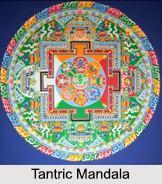 Tantric Mandala is a pictorial representation of divine forces. This Mandala plays an important role in both Hinduism and Buddhism. The tradition of Tantra asserts that these divine forms do not exist as objective entities. However it is not necessary to develop the idea of divinity in human form in order to create awareness in the common man.
Tantric Mandala is a pictorial representation of divine forces. This Mandala plays an important role in both Hinduism and Buddhism. The tradition of Tantra asserts that these divine forms do not exist as objective entities. However it is not necessary to develop the idea of divinity in human form in order to create awareness in the common man.
Tantric Mandala can be read and studied like a text and most important, be used for tantric meditation. The purpose of a Mandala is to acquaint the student with the Tantra, and thus allowing the student to identify with the deity and its sacred surroundings as the Mandala.
Types of Mandala
During Tantric initiations, two types of Mandala are present:
i. The space in which the ritual occurs is sacred and it is considered a Mandala.
ii. A three dimensional image is created which implies the residence of the Tantric deity. The participants are able to see it as they move front for various empowerments.
Iconography of Tantric Mandala
According to Tantra, a man who is incapable of seeing within him cannot experience the formless reality. Therefore the Mandala forms of Gods and Goddesses have been developed into elaborate and visual symbols. Nevertheless the imagination of divinity has to be finally surpassed and widened into the experience of shapeless realism. The Mandala symbol of Devis and Devas cover an endless array of forms, colours and depictions. Some are beautiful, others provocative, some kind, others bizarre and fear-provoking and some are divine. The deities and other images within the Mandala represent for example the sense organs, the elements and mental aspects, all in a purified state. In each of the Mandala, the structure is in detail and designed so as to evoke a consequent response within the aspirant`s consciousness.
Effects of Tantric Mandala
Mandala is based on the perpetual model structure of man"s collective unconsciousness. These Mandalas draw out these archetypes in the manner of a magnet drawing out iron filings from diamonds. The more one concentrates on a Mandala, the deep Samskaras within are awakened as well as reveals the unknown through dreams, visions and mental action. The aspirant is not forced to face the Samskaras directly, so it does not affect ones normal routine. It is a way of bypassing a fearsome enemy against which one cannot defend himself. Mandalas are aesthetic and visually impressive in nature. They are able to capture and direct the imagination which links the mind.
Practice of Tantric Mandala
The participants will offer rice which is symbolic of wealth, by throwing it at least twice during the rite. The rice is swept up and collected to feed to birds and other animals. The use of fingers is a symbolic gesture of offering the world.




















